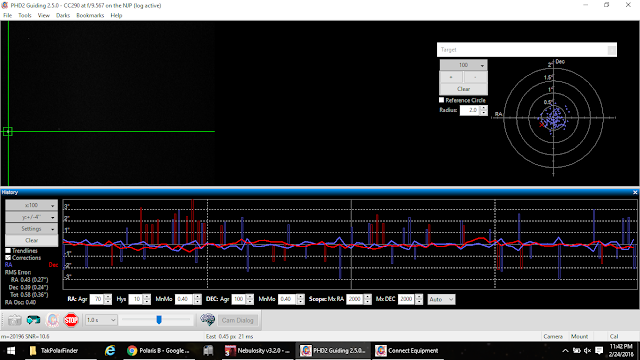This past week I celebrated first light with the CC290, a classical cassegrain built by CFF Telescopes. The scope arrived last week. I've had two great nights of visual viewing and a great night of imaging with it. I hope to write a full review later. Just two comments for now.
First, some notes from the visual. I set the scope out and ran the fans for a while. On the visual nights, the temp was around 41F, so the scope took a bit to cool. Once it cooled down, images were stunning!
One highlight of the first night was IC 418. IC 418's central star was obvious, and the oval ring around the star was obvious, too, at 157x with a 25mm TV Plossl.
The showpiece of the first night was the Trapezium. The E and F stars shown out like searchlights! I've never seen them so bright and clear! Clear, empty space between the F and D stars and between A and E. It was an awesome sight! The nebula was bright, too, and I could begin to see some color in it, mostly green, even from my suburban location.
The second night was just as cold, so the scope took a while to cool off. This night was also first light with a Baader Zeiss 2" prism diagonal. I used several eyepieces. One was a Meade 28mm. This eyepiece yields 140x, an exit pupil of 2.07, and a true field of .486 degrees. For greater magnification, I used the Televue 25mm plossl (very sharp, 157x, 1.85 exit pupil, and 0.318 degree field) and the Orion 15mm expanse (261x, an exit pupil of 1.11, and a true field of 0.261). Here are notes on some objects observed:
NGC 2438 in M46 - a ghostly round glow, gray and uniform as far as I could tell, visible only in the 28mm.
Eskimo Nebula: a bulbous shape and two levels of brightness (inner and outer), central star obvious. Very bright! Nicely studied in the 28mm and the 25mm plossl.
NGC 2371 - I can see two gray lobes clearly. Best in the 28mm.
M65, M66, M96, M95, M105, NGC 2903, NGC 3626 - all good but just faint fuzzies of varying shapes.
NGC 2419 -very dim in the 25mm, not a real showcase.
Sirius B - tougher than I thought it would be in the 15mm, but there is that little star.
A few nights later, the sky was clear, and I set up for imaging. The real test was whether the scope would guide at f/10. I have an Astro-Physics CCDT67 reducer. Set up to reduce at about 0.5873x, the reducer yields round stars across my smaller ccd chip. That gives me an effective focal length of 2299mm. Could the NJP guide at that length? This is an effective focal ratio of f/7.93.
I thought since the Eskimo Nebula was so bright that it would be a good target. I slewed over and, yes, there it was on my computer screen. But . . . no guide star in my off-axis guider. But the nebula was so bright. I decided to catch 300 five-second subs and stack them just for fun, so here's the result.
This is not a real attempt, just fun with the camera and scope. The subs were unguided, and there was some smearing from seeing and perhaps from the mount's movement, though the mount tracks extremely well. Anyway, someday I'd like to go back and get the nebula with narrowband filters.
After that, I slewed to a couple of galaxies in M44, where I knew I would have guide stars. Sure enough, I did, and I tried guiding. I'm still dancing around (metaphorically) from the result! Can this scope guide on the NJP at 2300mm? Absolutely! Actually, seeing was good, and guiding was under one arc second, peak to peak. How's that for fun?!? I took four 500-second images of some very distant galaxies behind M44, then slewed over to NGC 2903 and took a quick five-minute sub. Should I post it? Here it is. It's just a single sub at nearly f/8, and no flats because I did not have time (which explains the donut in the upper right). Contrast is poor, and the image is kind of grainy, but look at the size of that thing.

All kinds of detail in that galaxy. I'm still a bit shocked and thrilled that the scope will guide at that focal length. Ah, this is going to be great! Of course, auto-guiding at that focal length would be impossible if the scope were not extremely well made, very stiff. The scope also handles temperature changes very well. Kudos and thanks to CFF! Here are some images of the scope.












